Unit 2 Meet My Family! Grammar in Use (教学课件)(共36张PPT,无素材)初中英语仁爱版(2024)七年级上册
文档属性
| 名称 | Unit 2 Meet My Family! Grammar in Use (教学课件)(共36张PPT,无素材)初中英语仁爱版(2024)七年级上册 | 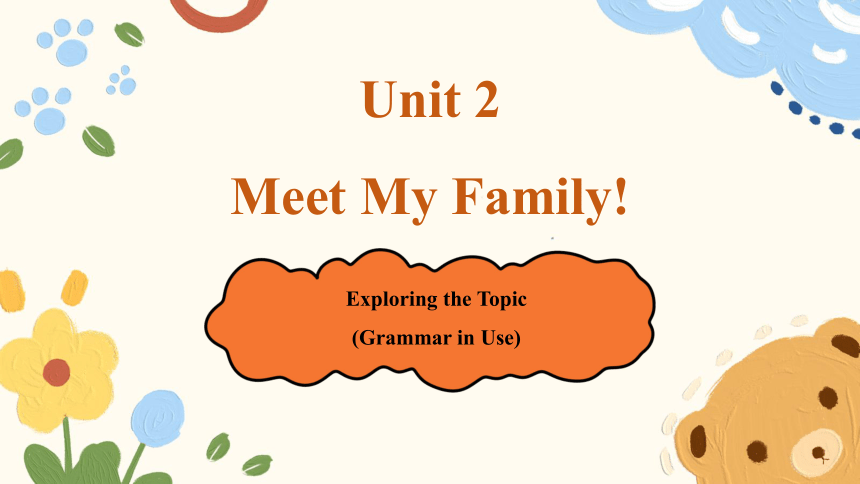 | |
| 格式 | pptx | ||
| 文件大小 | 59.0MB | ||
| 资源类型 | 教案 | ||
| 版本资源 | 仁爱科普版 | ||
| 科目 | 英语 | ||
| 更新时间 | 2025-07-04 20:57:22 | ||
图片预览

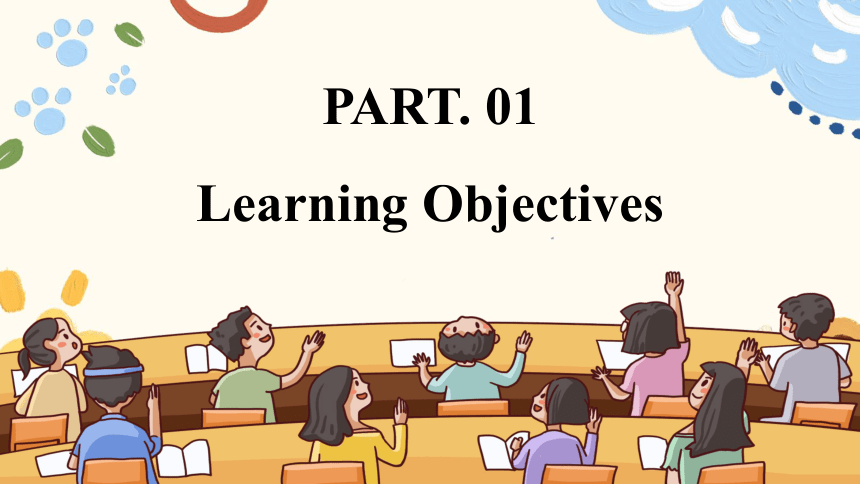
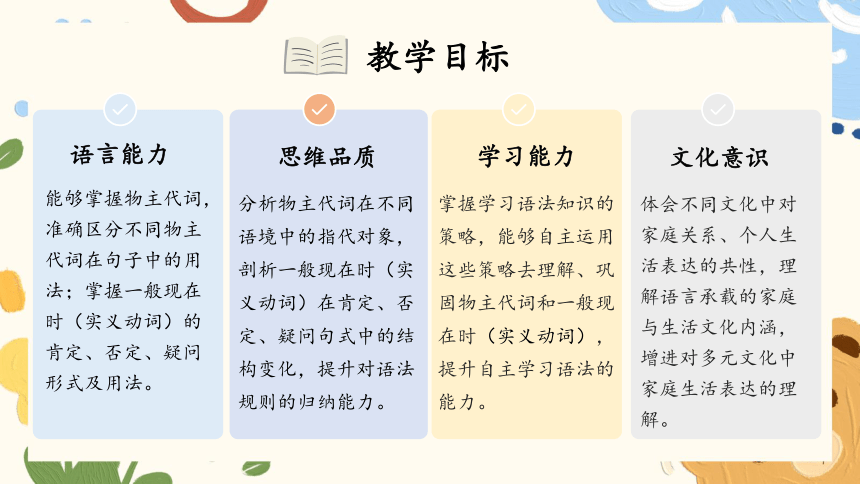
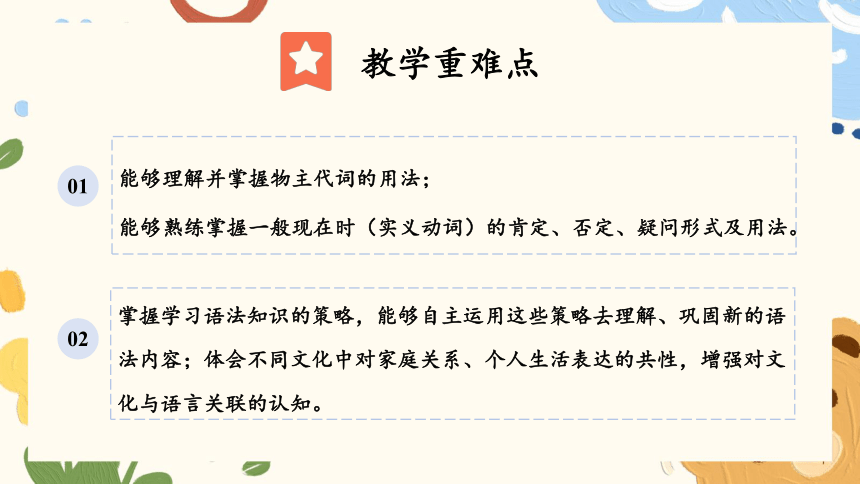

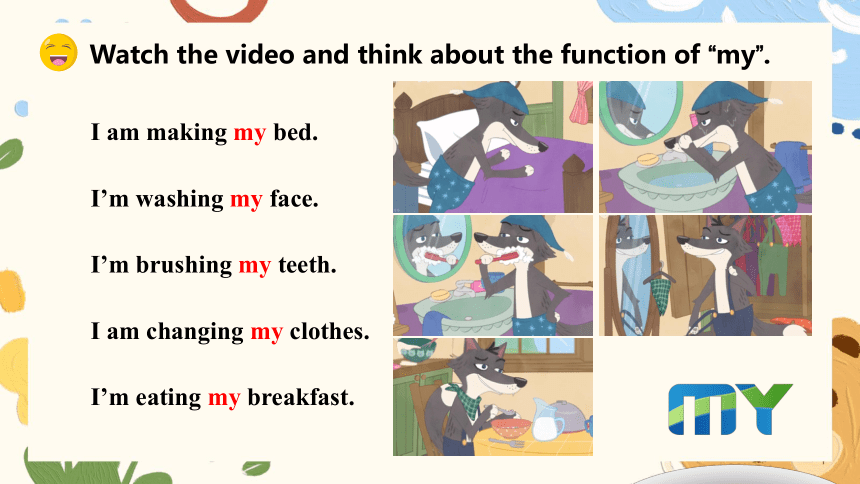
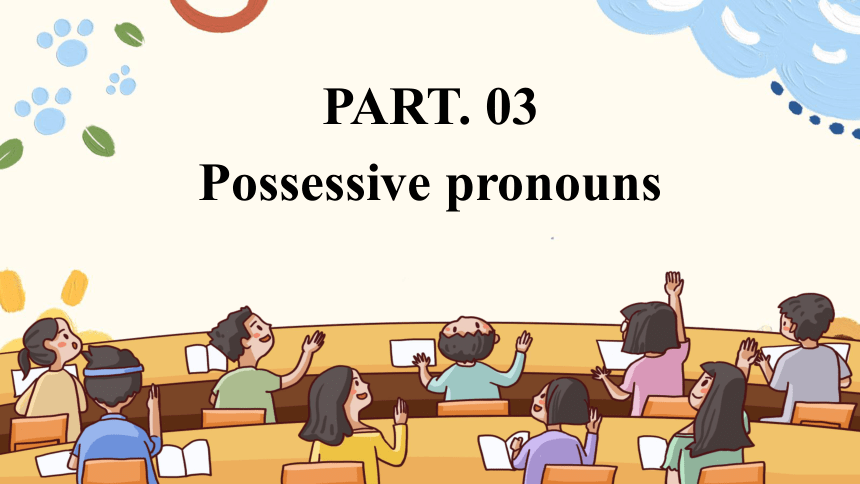
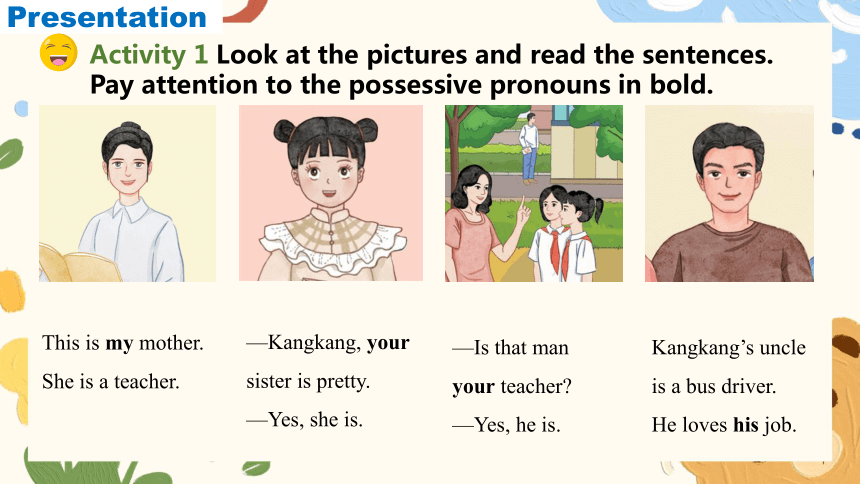
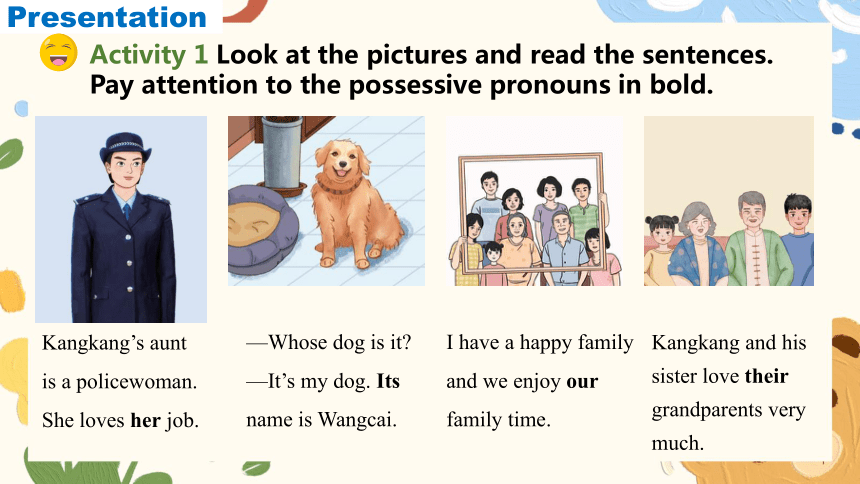
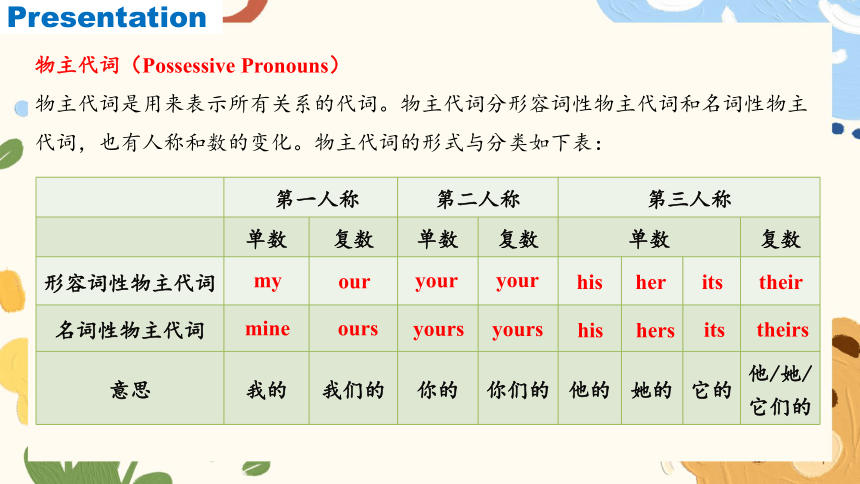
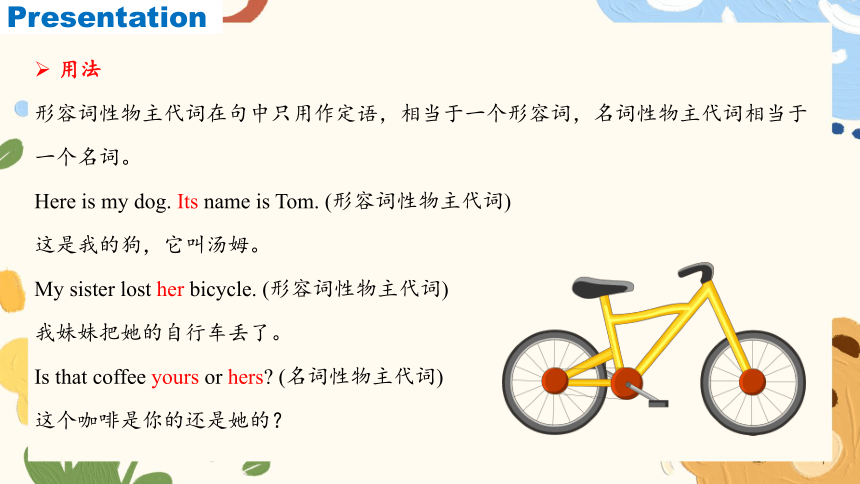
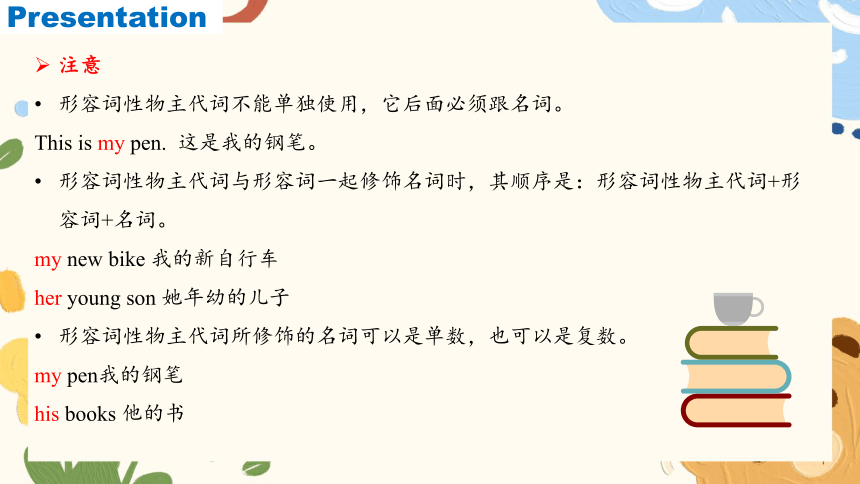
文档简介
(共36张PPT)
Exploring the Topic
(Grammar in Use)
Unit 2
Meet My Family!
PART. 01
Learning Objectives
思维品质
学习能力
文化意识
语言能力
教学目标
能够掌握物主代词,准确区分不同物主代词在句子中的用法;掌握一般现在时(实义动词)的肯定、否定、疑问形式及用法。
体会不同文化中对家庭关系、个人生活表达的共性,理解语言承载的家庭与生活文化内涵,增进对多元文化中家庭生活表达的理解。
掌握学习语法知识的策略,能够自主运用这些策略去理解、巩固物主代词和一般现在时(实义动词),提升自主学习语法的能力。
分析物主代词在不同语境中的指代对象,剖析一般现在时(实义动词)在肯定、否定、疑问句式中的结构变化,提升对语法规则的归纳能力。
教学重难点
能够理解并掌握物主代词的用法;
能够熟练掌握一般现在时(实义动词)的肯定、否定、疑问形式及用法。
掌握学习语法知识的策略,能够自主运用这些策略去理解、巩固新的语法内容;体会不同文化中对家庭关系、个人生活表达的共性,增强对文化与语言关联的认知。
01
02
PART. 02
Lead-in
Watch the video and think about the function of “my”.
I am making my bed.
I’m washing my face.
I’m brushing my teeth.
I am changing my clothes.
I’m eating my breakfast.
PART. 03
Possessive pronouns
Presentation
Activity 1 Look at the pictures and read the sentences. Pay attention to the possessive pronouns in bold.
This is my mother.
She is a teacher.
—Kangkang, your sister is pretty.
—Yes, she is.
—Is that man your teacher
—Yes, he is.
Kangkang’s uncle is a bus driver. He loves his job.
Presentation
Activity 1 Look at the pictures and read the sentences. Pay attention to the possessive pronouns in bold.
Kangkang’s aunt is a policewoman. She loves her job.
—Whose dog is it
—It’s my dog. Its name is Wangcai.
I have a happy family and we enjoy our family time.
Kangkang and his sister love their grandparents very much.
Presentation
物主代词(Possessive Pronouns)
物主代词是用来表示所有关系的代词。物主代词分形容词性物主代词和名词性物主代词,也有人称和数的变化。物主代词的形式与分类如下表:
第一人称 第二人称 第三人称 单数 复数 单数 复数 单数 复数
形容词性物主代词
名词性物主代词
意思 我的 我们的 你的 你们的 他的 她的 它的 他/她/它们的
mine
my
your
his
her
its
yours
his
hers
its
our
your
their
ours
yours
theirs
Presentation
用法
形容词性物主代词在句中只用作定语,相当于一个形容词,名词性物主代词相当于一个名词。
Here is my dog. Its name is Tom. (形容词性物主代词)
这是我的狗,它叫汤姆。
My sister lost her bicycle. (形容词性物主代词)
我妹妹把她的自行车丢了。
Is that coffee yours or hers (名词性物主代词)
这个咖啡是你的还是她的?
Presentation
注意
形容词性物主代词不能单独使用,它后面必须跟名词。
This is my pen. 这是我的钢笔。
形容词性物主代词与形容词一起修饰名词时,其顺序是:形容词性物主代词+形容词+名词。
my new bike 我的新自行车
her young son 她年幼的儿子
形容词性物主代词所修饰的名词可以是单数,也可以是复数。
my pen我的钢笔
his books 他的书
Presentation
注意
当名词前有形容词性物主代词修饰时,不能再用冠词a, an或the来修饰名词。
那是我的自行车。
That is my bike. (√)
This is my a bike. (×)
当名词前有形容词性物主代词修饰时,不能再用指示代词 this, that, these 或 those 来修饰名词。
他们的电脑在这儿。
Their computers are here. (√)
Their those computers are here. (×)
Practice
Activity 2 Complete the table with the correct form of the personal pronouns.
you
my
his
our
your
their
she
Practice
Choose the possessive pronouns correctly.
he
her
me
we
I
our
mine
you
its
him
it
they
my
she
yours
myself
their
his
Activity 3 Read the text and fill in the blanks with correct pronouns.
Production
Mr. and Mrs. Yang have a happy family. They have two children and a cat. This is _____ son. _____ name is Yang Guang. He likes swimming and riding _____ bike. Yang Guang has a sister. _____ name is Yang Yu. She is pretty and she likes dancing. The cat is black. _____ name is Xiaohei.
their
His
his
Her
Its
Fill in the blanks with correct pronouns.
Production
Look at the classroom! This is ______ (we) classroom. That red bag is Sarah’s. It’s ______ (she) bag. The blue pencil case on the desk is Mike’s. It’s ______ (he). Where is ______ (I) ruler Oh, it’s in ______ (you) pencil box! Jim and Tom are cleaning ______ (they) desks. Linda is helping ______ (we) put up ______ (we) posters. Whose books are those They’re ______ (they) books for the reading class. Please give ______ (they) to ______ (they) before class!
our
her
his
my
your
their
us
our
their
them
them
PART. 04
The simple present tense (2)
Activity 1 Pair work. Read the conversation. Pay attention to the words in bold.
Presentation
Presentation
一般现在时(The present simple tense)
动词do的一般现在时
英语中动词“do”的含义是“做、干、办(某事)”时是行为动词。
一般现在时中行动词do有两种形式,即动词原形do和第三人称单数形式does。其否定句、疑问句的构成要借助于助动词 do和 does(无实际意义)。
其肯定回答为:Yes, 主语(人称代词主格)+do/does;
否定回答为:No, 主语(人称代词主格)+don’t/doesn’t.
注:第一人称、第二人称和所有人称的复数都用do,第三人称单数用does。
—Does he do research for his project 他为项目做调研吗?
—Yes, he does. / No, he doesn’t.
Presentation
2. 行为动词的第三人称单数形式变化规则如下表:
疑问形式 简略答语 词尾发音 例词
一般情况 加-s 1. 在清辅音后读/s/ 2. 在元音和浊辅音后读/z/ 3. 在以ce, se, ze, (d)ge等结尾的词后读/ z/ like—likes
tell—tells
play—plays
place—places (安放)
以s, x, ch, sh结尾的词 加 -es 读/ z/ guess—guesses
teach—teaches
finish—finishes
以辅音字母加y结尾的词 将y变为i再加-es 读/z/ fly—flies
carry—carries
以o结尾的词 加 -es 读/z/ do—does
go—goes
注意:
have 的第三人称单数形式是has。
Activity 2 Complete the tables and learn how to use the simple present tense.
Presentation
Negative
I/You/We/They
don’t like
He/She/It
____________
Positive
I/You/We/They
like
He/She/It
______
Question Short Answer
Do
I/you/we/they
_____.
____
don’t.
______.
No,
he/she/it
Yes,
singing.
singing.
you/I/we/they
he/she/it
does.
I/you/we/they
he/she/it
like singing
likes
Does
doesn’t
doesn’t like
do
Don’t or Doesn’t
Practice
We (don’t/doesn’t) go to school on Sundays.
(Don’t/Doesn’t) the dog bark at night
(Don’t/Doesn’t) your parents watch movies on weekends
(Don’t/Doesn’t) the bird sing in the morning
My brother (don’t/doesn’t) like getting up early.
They (don’t/doesn’t) play games on school days.
Activity 3 Group work. Read the example and complete the table, and then make short conversations.
Production
Example:
—Does Li Xiang like swimming —Yes, he does.
—Do you like swimming —Yes, I do./No, I don’t.
—What do you like —I like dancing.
Make up conversations about your family.
Production
…, do you like …
Yes, I do. / No, I don’t.
My … likes ...
Does … like …
Yes, … does./No, … doesn’t. He/She …
PART. 05
Language Points
1. —Whose dog is it —这是谁的狗?
—It’s my dog. —这是我的狗。
whose意为“谁的”,表示所属关系,在句中既可单独使用,也可与名词连用;其答语可以用“形容词性物主代词+名词”来回答。
—Whose T-shirt is this = Whose is this T-shirt ——这是谁的T恤?
—It’s her T-shirt. ——这是她的T恤。
—Whose ruler is this = Whose is this ruler ——这是谁的尺子?
—It’s our ruler. ——这是我们的尺子。
PART. 06
Exercises
Exercise—单选题
1.—______ pen is on the desk
—It’s his pen.
A. Who B. Whose C. What
2. The book is not mine. It’s ______.
A. her B. hers C. she
3. —Is this ______ bag
—Yes, she ______ it every day.
A. her; carry B. hers; carries C. her; carries
Exercise—单选题
4. This is not my ruler. ______ is blue. I ______ it in my pencil - box.
A. Mine; find B. My; finds C. Mine; finds
5. My mother ______ dinner for us every evening.
A. cooks B. cook C. cooking
6. ______ classroom is big. They ______ lessons here.
A. Their; have B. Theirs; has C. They; have
Exercise—根据句意及汉语提示填写单词
1. My ______(儿子), who loves playing football, joins the school team this term.
2. The little girl learns to ______(骑) a small bicycle, and her parents cheer for her.
3. What ______(工作) do you want to have in the future, a doctor or a teacher
son
ride
job
PART. 07
Summary
New words: son, ride
Expressions: I/You/We/They (don’t) like ...
He/She/It likes ...
He/She/It doesn’t like ...
— Do I/you/we/they ...
— Yes, you/I/we/they do. / No, you/I/we/they don’t.
— Does he/she/it ...
— Yes, he/she/it does. / No, he/she/it is doesn’t.
Functions: 物主代词的用法;
一般现在时中be动词的肯定、否定、疑问形式及用法。
Sentences: Whose dog is it
PART. 08
Homework
Use a thinking map to summarize what we learned today.
Write a short text to introduce your family members’ likes and dislikes.
Homework
See you next class!
Exploring the Topic
(Grammar in Use)
Unit 2
Meet My Family!
PART. 01
Learning Objectives
思维品质
学习能力
文化意识
语言能力
教学目标
能够掌握物主代词,准确区分不同物主代词在句子中的用法;掌握一般现在时(实义动词)的肯定、否定、疑问形式及用法。
体会不同文化中对家庭关系、个人生活表达的共性,理解语言承载的家庭与生活文化内涵,增进对多元文化中家庭生活表达的理解。
掌握学习语法知识的策略,能够自主运用这些策略去理解、巩固物主代词和一般现在时(实义动词),提升自主学习语法的能力。
分析物主代词在不同语境中的指代对象,剖析一般现在时(实义动词)在肯定、否定、疑问句式中的结构变化,提升对语法规则的归纳能力。
教学重难点
能够理解并掌握物主代词的用法;
能够熟练掌握一般现在时(实义动词)的肯定、否定、疑问形式及用法。
掌握学习语法知识的策略,能够自主运用这些策略去理解、巩固新的语法内容;体会不同文化中对家庭关系、个人生活表达的共性,增强对文化与语言关联的认知。
01
02
PART. 02
Lead-in
Watch the video and think about the function of “my”.
I am making my bed.
I’m washing my face.
I’m brushing my teeth.
I am changing my clothes.
I’m eating my breakfast.
PART. 03
Possessive pronouns
Presentation
Activity 1 Look at the pictures and read the sentences. Pay attention to the possessive pronouns in bold.
This is my mother.
She is a teacher.
—Kangkang, your sister is pretty.
—Yes, she is.
—Is that man your teacher
—Yes, he is.
Kangkang’s uncle is a bus driver. He loves his job.
Presentation
Activity 1 Look at the pictures and read the sentences. Pay attention to the possessive pronouns in bold.
Kangkang’s aunt is a policewoman. She loves her job.
—Whose dog is it
—It’s my dog. Its name is Wangcai.
I have a happy family and we enjoy our family time.
Kangkang and his sister love their grandparents very much.
Presentation
物主代词(Possessive Pronouns)
物主代词是用来表示所有关系的代词。物主代词分形容词性物主代词和名词性物主代词,也有人称和数的变化。物主代词的形式与分类如下表:
第一人称 第二人称 第三人称 单数 复数 单数 复数 单数 复数
形容词性物主代词
名词性物主代词
意思 我的 我们的 你的 你们的 他的 她的 它的 他/她/它们的
mine
my
your
his
her
its
yours
his
hers
its
our
your
their
ours
yours
theirs
Presentation
用法
形容词性物主代词在句中只用作定语,相当于一个形容词,名词性物主代词相当于一个名词。
Here is my dog. Its name is Tom. (形容词性物主代词)
这是我的狗,它叫汤姆。
My sister lost her bicycle. (形容词性物主代词)
我妹妹把她的自行车丢了。
Is that coffee yours or hers (名词性物主代词)
这个咖啡是你的还是她的?
Presentation
注意
形容词性物主代词不能单独使用,它后面必须跟名词。
This is my pen. 这是我的钢笔。
形容词性物主代词与形容词一起修饰名词时,其顺序是:形容词性物主代词+形容词+名词。
my new bike 我的新自行车
her young son 她年幼的儿子
形容词性物主代词所修饰的名词可以是单数,也可以是复数。
my pen我的钢笔
his books 他的书
Presentation
注意
当名词前有形容词性物主代词修饰时,不能再用冠词a, an或the来修饰名词。
那是我的自行车。
That is my bike. (√)
This is my a bike. (×)
当名词前有形容词性物主代词修饰时,不能再用指示代词 this, that, these 或 those 来修饰名词。
他们的电脑在这儿。
Their computers are here. (√)
Their those computers are here. (×)
Practice
Activity 2 Complete the table with the correct form of the personal pronouns.
you
my
his
our
your
their
she
Practice
Choose the possessive pronouns correctly.
he
her
me
we
I
our
mine
you
its
him
it
they
my
she
yours
myself
their
his
Activity 3 Read the text and fill in the blanks with correct pronouns.
Production
Mr. and Mrs. Yang have a happy family. They have two children and a cat. This is _____ son. _____ name is Yang Guang. He likes swimming and riding _____ bike. Yang Guang has a sister. _____ name is Yang Yu. She is pretty and she likes dancing. The cat is black. _____ name is Xiaohei.
their
His
his
Her
Its
Fill in the blanks with correct pronouns.
Production
Look at the classroom! This is ______ (we) classroom. That red bag is Sarah’s. It’s ______ (she) bag. The blue pencil case on the desk is Mike’s. It’s ______ (he). Where is ______ (I) ruler Oh, it’s in ______ (you) pencil box! Jim and Tom are cleaning ______ (they) desks. Linda is helping ______ (we) put up ______ (we) posters. Whose books are those They’re ______ (they) books for the reading class. Please give ______ (they) to ______ (they) before class!
our
her
his
my
your
their
us
our
their
them
them
PART. 04
The simple present tense (2)
Activity 1 Pair work. Read the conversation. Pay attention to the words in bold.
Presentation
Presentation
一般现在时(The present simple tense)
动词do的一般现在时
英语中动词“do”的含义是“做、干、办(某事)”时是行为动词。
一般现在时中行动词do有两种形式,即动词原形do和第三人称单数形式does。其否定句、疑问句的构成要借助于助动词 do和 does(无实际意义)。
其肯定回答为:Yes, 主语(人称代词主格)+do/does;
否定回答为:No, 主语(人称代词主格)+don’t/doesn’t.
注:第一人称、第二人称和所有人称的复数都用do,第三人称单数用does。
—Does he do research for his project 他为项目做调研吗?
—Yes, he does. / No, he doesn’t.
Presentation
2. 行为动词的第三人称单数形式变化规则如下表:
疑问形式 简略答语 词尾发音 例词
一般情况 加-s 1. 在清辅音后读/s/ 2. 在元音和浊辅音后读/z/ 3. 在以ce, se, ze, (d)ge等结尾的词后读/ z/ like—likes
tell—tells
play—plays
place—places (安放)
以s, x, ch, sh结尾的词 加 -es 读/ z/ guess—guesses
teach—teaches
finish—finishes
以辅音字母加y结尾的词 将y变为i再加-es 读/z/ fly—flies
carry—carries
以o结尾的词 加 -es 读/z/ do—does
go—goes
注意:
have 的第三人称单数形式是has。
Activity 2 Complete the tables and learn how to use the simple present tense.
Presentation
Negative
I/You/We/They
don’t like
He/She/It
____________
Positive
I/You/We/They
like
He/She/It
______
Question Short Answer
Do
I/you/we/they
_____.
____
don’t.
______.
No,
he/she/it
Yes,
singing.
singing.
you/I/we/they
he/she/it
does.
I/you/we/they
he/she/it
like singing
likes
Does
doesn’t
doesn’t like
do
Don’t or Doesn’t
Practice
We (don’t/doesn’t) go to school on Sundays.
(Don’t/Doesn’t) the dog bark at night
(Don’t/Doesn’t) your parents watch movies on weekends
(Don’t/Doesn’t) the bird sing in the morning
My brother (don’t/doesn’t) like getting up early.
They (don’t/doesn’t) play games on school days.
Activity 3 Group work. Read the example and complete the table, and then make short conversations.
Production
Example:
—Does Li Xiang like swimming —Yes, he does.
—Do you like swimming —Yes, I do./No, I don’t.
—What do you like —I like dancing.
Make up conversations about your family.
Production
…, do you like …
Yes, I do. / No, I don’t.
My … likes ...
Does … like …
Yes, … does./No, … doesn’t. He/She …
PART. 05
Language Points
1. —Whose dog is it —这是谁的狗?
—It’s my dog. —这是我的狗。
whose意为“谁的”,表示所属关系,在句中既可单独使用,也可与名词连用;其答语可以用“形容词性物主代词+名词”来回答。
—Whose T-shirt is this = Whose is this T-shirt ——这是谁的T恤?
—It’s her T-shirt. ——这是她的T恤。
—Whose ruler is this = Whose is this ruler ——这是谁的尺子?
—It’s our ruler. ——这是我们的尺子。
PART. 06
Exercises
Exercise—单选题
1.—______ pen is on the desk
—It’s his pen.
A. Who B. Whose C. What
2. The book is not mine. It’s ______.
A. her B. hers C. she
3. —Is this ______ bag
—Yes, she ______ it every day.
A. her; carry B. hers; carries C. her; carries
Exercise—单选题
4. This is not my ruler. ______ is blue. I ______ it in my pencil - box.
A. Mine; find B. My; finds C. Mine; finds
5. My mother ______ dinner for us every evening.
A. cooks B. cook C. cooking
6. ______ classroom is big. They ______ lessons here.
A. Their; have B. Theirs; has C. They; have
Exercise—根据句意及汉语提示填写单词
1. My ______(儿子), who loves playing football, joins the school team this term.
2. The little girl learns to ______(骑) a small bicycle, and her parents cheer for her.
3. What ______(工作) do you want to have in the future, a doctor or a teacher
son
ride
job
PART. 07
Summary
New words: son, ride
Expressions: I/You/We/They (don’t) like ...
He/She/It likes ...
He/She/It doesn’t like ...
— Do I/you/we/they ...
— Yes, you/I/we/they do. / No, you/I/we/they don’t.
— Does he/she/it ...
— Yes, he/she/it does. / No, he/she/it is doesn’t.
Functions: 物主代词的用法;
一般现在时中be动词的肯定、否定、疑问形式及用法。
Sentences: Whose dog is it
PART. 08
Homework
Use a thinking map to summarize what we learned today.
Write a short text to introduce your family members’ likes and dislikes.
Homework
See you next class!
同课章节目录
